A local government is a form of public administration which, in a majority of contexts, exists as the lowest tier of administration within a given state. The term is used to contrast with offices at state level, which are referred to as the central government, national government, or federal government and also to supranational government which deals with governing institutions between states. Local governments generally act within powers delegated to them by legislation or directives of the higher level of government. In federal states, local government generally comprises the third tier of government, whereas in unitary states, local government usually occupies the second or third tier of government, often with greater powers than higher-level administrative divisions.

Bergen, historically Bjørgvin, is a city and municipality in Vestland county on the west coast of Norway. At the end of 2019, the municipality's population was 283,929. Bergen is the second-largest city in Norway. The municipality covers 465 square kilometres (180 sq mi) and is on the peninsula of Bergenshalvøyen. The city centre and northern neighbourhoods are on Byfjorden, 'the city fjord', and the city is surrounded by mountains; Bergen is known as the 'city of seven mountains'. Many of the extra-municipal suburbs are on islands. Bergen is the administrative centre of Vestland county. The city consists of eight boroughs: Arna, Bergenhus, Fana, Fyllingsdalen, Laksevåg, Ytrebygda, Årstad, and Åsane.

Transport in Norway is highly influenced by Norway's low population density, narrow shape and long coastline. Norway has old water transport traditions, but road, rail and air transport have increased in importance during the 20th century. Due to the low population density, public transport is somewhat less built out in rural areas of Norway, however public transport in, and around cities is well developed.

Stavanger is a city and municipality in Norway. It is the fourth largest city and third largest metropolitan area in Norway and the administrative centre of Rogaland county. The municipality is the fourth most populous in Norway. Located on the Stavanger Peninsula in Southwest Norway, Stavanger counts its official founding year as 1125, the year the Stavanger Cathedral was completed. Stavanger's core is to a large degree 18th- and 19th-century wooden houses that are protected and considered part of the city's cultural heritage. This has caused the town centre and inner city to retain a small-town character with an unusually high ratio of detached houses, and has contributed significantly to spreading the city's population growth to outlying parts of Greater Stavanger.

Sandnes (help·info) is municipality in Rogaland county, Norway. It lies immediately south of the city of Stavanger, the 4th largest city in Norway and together, the Stavanger/Sandnes area is the 3rd largest urban area in Norway. The urban city of Sandnes lies in the extreme western part of the vast municipality and it makes up about 5% of the total land area of the municipality.
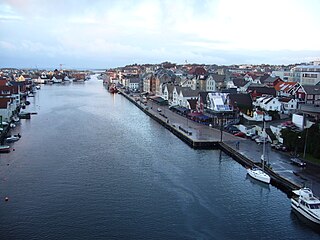
Haugesund (help·info) is a municipality on the North Sea in Rogaland county, Norway. The town of Haugesund is the main population centre and administrative centre of the municipality. The town is also the main commercial and economic centre of the Haugaland region in northern Rogaland and southern Vestland. The majority of the population of Haugesund lives in the town of Haugesund, with the majority of the municipality outside the town being fairly rural.
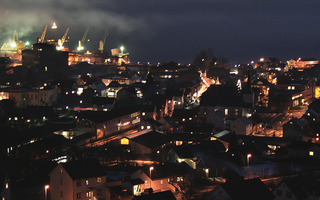
Sauda(listen ) is a municipality in Rogaland county, Norway. The administrative centre of the municipality is the town of Sauda, where most of the population lives. Other villages in the municipality include Saudasjøen and Amdal. Despite being in the northern part of the region of Ryfylke, Sauda participates in the Haugalandet Council and is under the jurisdiction of the Haugaland District Court.

Os is a former municipality in the old Hordaland county, Norway. It was located in the Midhordland region, just south of Norway's second-largest city, Bergen. Due to its proximity to Bergen, Os experienced strong population growth. The administrative centre of Os was the village of Osøyro. It is the largest settlement in the municipality, with over 60% of the municipal residents living here. Other large villages in Os included Hagavik, Halhjem, Søfteland, Søre Øyane, and Søvik.

Norway is divided into 11 administrative regions, called counties until 1918, they were known as amter. The counties form the first-level subdivisions of Norway and are further divided into 356 municipalities. The island territories of Svalbard and Jan Mayen are outside the county division and ruled directly at the national level. The capital Oslo is considered both a county and a municipality.

Vygruppen, branded as Vy, formerly Norges Statsbaner (NSB), is a government-owned railway company which operates most passenger train services and many bus services in Norway. The company is owned by the Norwegian Ministry of Transport and Communications. Its sub-brands include Vy Buss coach services, CargoNet freight trains through and the Swedish train transport company Tågkompaniet. In 2009 NSB carried 52 million train passengers and 104 million bus passengers. On 24 April 2019, passenger train and bus services were rebranded by as Vy.
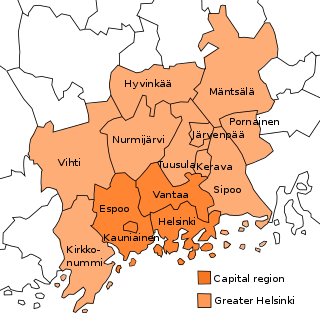
Greater Helsinki is the metropolitan area surrounding Helsinki, the capital city of Finland. It includes the smaller Capital Region urban area.

Kristiansand Region is a statistical metropolitan region in the counties of Vest-Agder and Aust-Agder in southern Norway. It is centered on the city of Kristiansand. The region consist of 6 municipalities in the centre of Southern Norway. Vennesla, Songdalen, and Birkenes are inland municipalities while Kristiansand, Søgne, and Lillesand are coastal municipalities. Kristiansand is the largest municipality in population in the region and Birkeland is the largest in area.
City region is a term in use since about 1950 by urbanists, economists and urban planners to mean a metropolitan area and hinterland, often having a shared administration. Typically, it denotes a city, conurbation or urban zone with multiple administrative districts, but sharing resources like a central business district, labour market and transport network such that it functions as a single unit.
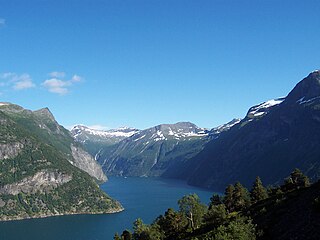
Western Norway is the region along the Atlantic coast of southern Norway. It consists of the counties Rogaland, Vestland and Møre og Romsdal. The region has a population of approximately 1.3 million people. The largest city is Bergen and the second-largest is Stavanger. Historically the regions of Agder, Vest-Telemark, Hallingdal, Valdres and northern parts of Gudbrandsdal have been included in Western Norway.

The City of Johannesburg Metropolitan Municipality is a metropolitan municipality that manages the local governance of Johannesburg, South Africa. It is divided into several branches and departments in order to expedite services for the city.
Opened on the 8th of October 1998, the only high-speed rail in Norway, on the railways of Norway is on Gardermobanen, a 64 kilometer line between Oslo Central Station and Eidsvoll via Oslo Airport. The main service on this route is Flytoget, commuting between Oslo Airport and the metropolitan areas of Oslo at speeds of up to 210 km/h (130 mph). It was extended westwards to include the city of Drammen in 2008, though not at high speed. The high-speed section is also used by express and regional trains between Oslo and Eidsvoll.

A metropolis is a large city or conurbation which is a significant economic, political, and cultural center for a country or region, and an important hub for regional or international connections, commerce, and communications. The term is Ancient Greek (μητρόπολις) and means the "mother city" of a colony, that is, the city which sent out settlers. This was later generalized to a city regarded as a center of a specified activity, or any large, important city in a nation.
Norway's elongated shape, its numerous internal geographical barriers, and the often widely dispersed and separated settlements are all factors that have strongly influenced the structure of the country's administrative subdivisions. This structure has varied over time and is subject to continuous review. As of late 2018, plans are nearing completion for a reform of the country's administrative divisions intended to lead, most notably, to the replacement of Norway's current 19 fylker (counties) by 11 new regioner.
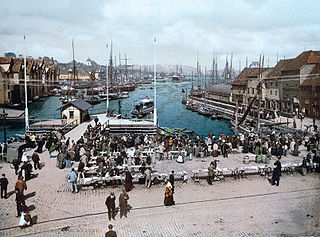
The Western Norway region of Norway showed the highest population growth rate in Norway in 2010, at 1.44%. The fertility rate in this region is higher than in other parts of Norway. The population as of 1 January 2010 was 1,263,464, with 37.7% of the population living in Hordaland, 33.8% in Rogaland, 19.8% in Møre og Romsdal, and 8.4% in Sogn og Fjordane. 60% of the population is under 40 years old, and 30% is under 20 years old. Many of the historical immigrants in Western Norway came from countries like Scotland, England, Netherlands, Germany, Denmark and Sweden. Western Norway is the part of Norway which has the largest immigration from the western world.















